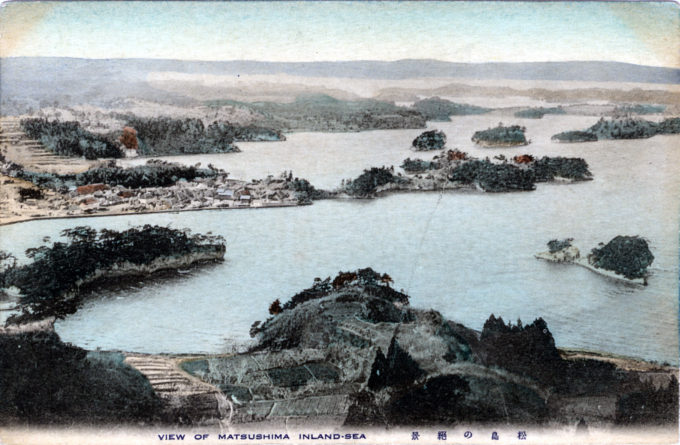
Aerial view of Matsushima, Inland Sea, c. 1920. The popular tourist destination, said to encompass more than 300 islands, is famous as being one the “Three Great Sights of Japan”, along with the Big Torii at Ise and the land-bridge at Ama-no-hashidate.
“The archipelago of pine-class islets collectively bearing the name Matsushima [lit. ‘pine islands’] has been famed for its beauty ever since Northern Japan was conquered from the Ainu aborigines in the 8th century, and ranks as one of the San-kei, or ‘Three Most Beautiful Scenes’ of the empire, the other two being Miyajima and Ama-no-Hashidate.
“… There are said to be 88 islands between Shiogama and Matsushima, and 808 in all between Shiogama and Kinkwa-zan, of which very few are inhabited. But eight and its compounds are favourite round numbers with the Japanese, and moreover the smallest rocks are included in the enumeration.
“The average height of the islands is from 60 ft. to 80 ft., the highest 300 ft. All are formed of volcanic tufa, into which the sea makes rapid inroads, hollowing out tunnels and archways in numerous places.
“Each island, down to the least, has received a separate name, many of them fantastic, as ‘Buddha’s Entry into Nirvana’, ‘Question and Answer Island’, the Twelve Imperial Consorts’, and so on; and no less fantastic than the names are the shapes of the islands themselves. In almost every available nook stands one of those thousand pine-trees that have given name and fame to the locality.”
– A Handbook for Travellers in Japan, by Basil Hall Chamberlain & W.B. Mason, 1901
See also:
Matsushima Park Hotel, Matsushima, c. 1920
“Although the Japanese class Matsushima, Miyahima, and Amanohashidate as the ‘Three Great Sights,’ two at least of these san-kei* are apt not to prove such to the average Occidental. [On the other hand,] Matsushima, unquestionably the loveliest of the trio, possesses an irresistible charm.
“Matsushima Bay faces the Pacific Ocean [near Sendai], and is said to contain 808 islands (albeit there are but about 300). All are of friable volcanic tufa that once formed part of the mainland; the constant erosion of wind and water is slowly changing the shape and reducing them, as if Nature was dissatisfied with her beautiful handiwork.
“Many of the islets are of fantastic shapes. Some are uninhabited; others (notably Hashikaki-jima) have tunnels worn through them by the action of the waves. Some are bare, but many are crowned with grotesque pine trees which stretch their gaunt arms overhead or reach them down along their precipitous sides. When the wind whips and sways them, they look almost human as they thrash about as if appealing for help.
“Like many lovely things Matsushima is capricious, and is subject to moods. The Japanese find beauty in it under all circumstances; when it lies soothed and hushed under golden sunlight; when wrapped in mist, or drenched in rain; or when the moon light idealizes it and imparts an almost superhuman beauty to it.”
– Terry’s Japanese Empire: A Handbook for Travellers, T. Phillip Terry, 1914
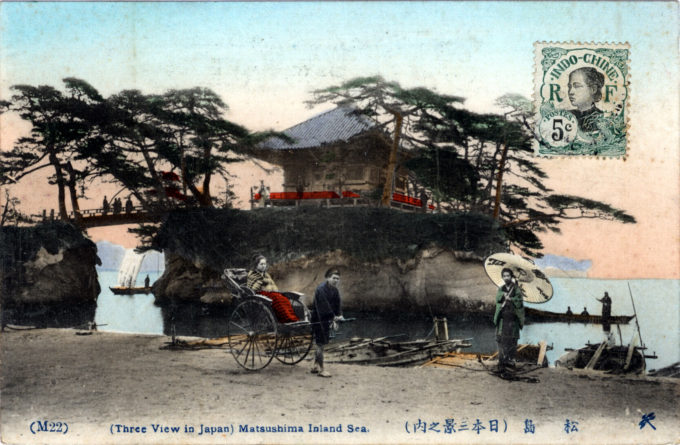
“(Three View in Japan)”, Matsushima, Inland Sea, c. 1910. The Japanese class Matsushima among the “Three Great Sights” (sankei), or must-see sights, of Japan including Miyahima and Amanohashidate.’
“If someone gave you some clay and some paint brushes and told you to fashion the ideal landscape you’d probably make a crooked range of mountains, colored with a hundred greens, that stopped abruptly at the edge of metallic blue water, and in this water you’d probably drop tiny islands covered with pines and blue bells – islands with sheer cliffs and islands with sandy coves – and if you were really in a creative mood you’d most likely put in a sailboat or two and maybe a curving red bridge between these islands fashioned from your fantasy.
“This would be your ideal landscape and you’d sigh and wonder why such a perfect place couldn’t exist.
“But it DOES exist! The velvety green mountains, the glassy blue water with its pine-clad islands – and where you might have omitted quaint little mud houses with thatched roofs and glass-walled inns that through fascinating reflections on the water at night – these additions have been supplied at Matsushima.”
– “Matsushima’s Tranquil Beauty”, by Mona Gardner, Japan Overseas Travel Magazine, September 1931
- Matsushima island (Three noted views in Japan), c. 1910.
- Kikojima, Matsushima, c. 1910.
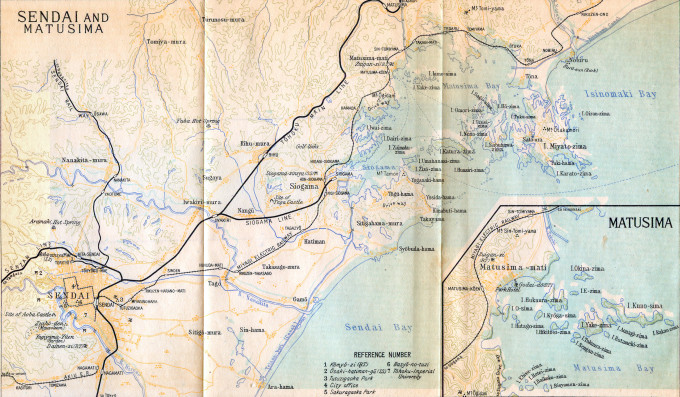
Map of Matsushima “Inland Sea” (upper right) and islands relative to Sendai along the Pacific coast of Tohoku. (Japan: The Official Guide, 1941)


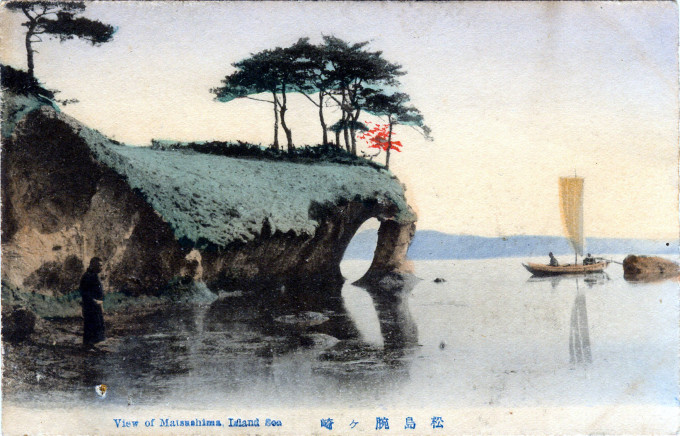
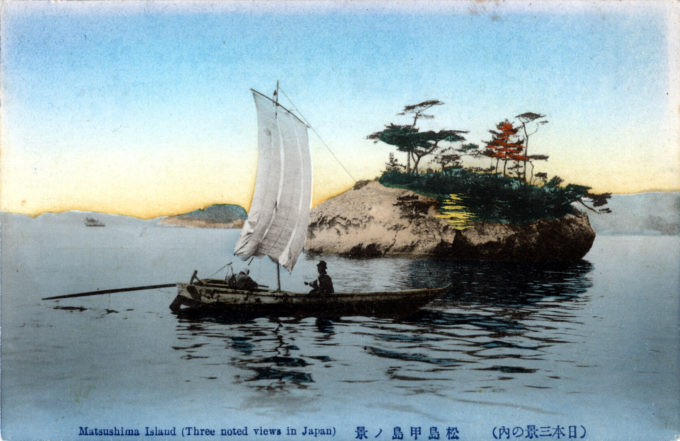
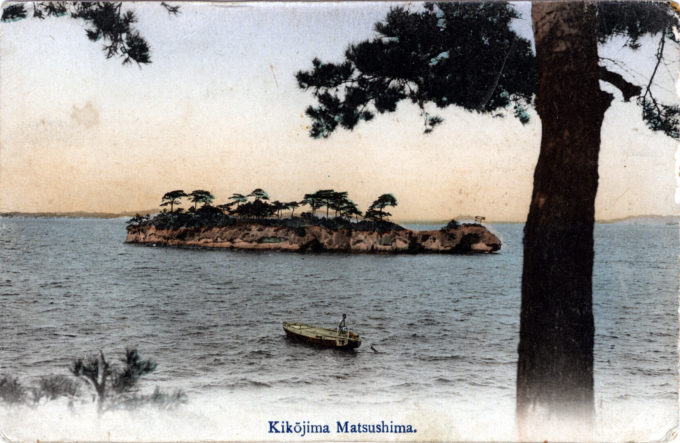
Pingback: Matsushima Park Hotel, Matsushima, c. 1920. | Old Tokyo
Pingback: Godaido Temple at Matsushima, Japan, c. 1910. | Old Tokyo
Pingback: The Big Torii from Matsubara Itsukushima, Aki, c. 1910. | Old Tokyo